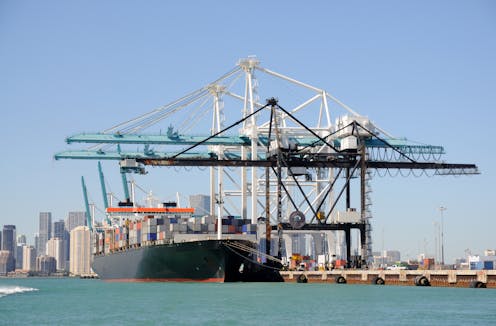What’s a trade war?

This article is part of The Conversation’s “Business Basics” series where we ask experts to discuss key concepts in business, economics and finance.
Thanks to US President-elect Donald Trump, the term “trade war” is back in the headlines. Trump campaigned successfully on a platform of aggressive trade policies, and since being elected, has only doubled down on this posture.
On Tuesday, he threatened Mexico and Canada with new 25% tariffs on all goods, and a separate “additional” 10% tariff on China “above any additional tariffs”.
While the term might conjure up dramatic images of battlefield tactics, the real economic impact of any looming trade war is likely to hit much closer to home – both for Americans and the rest of the world.
Global supply chains are deeply interlinked. That means a major trade war initiated by the US could push up the prices of all kinds of goods – from new cars to Australian-inspired avocado on toast.
To understand where we might be headed, it’s worth unpacking the metaphor. What exactly is a trade war? What are the “weapons” countries use? Perhaps most importantly – can either side win?
The weapons of war
There are many “weapons” available to a country in a trade war, but tariffs are often a popular choice. This is simply an extra tax put on a product as it crosses a border as an import.
For example, all else equal, Trump’s proposed 25% tariff on goods from Canada would bump the price of a $32,000 Canadian-built car up to $40,000.
Tariffs are usually paid by whoever is importing the product and paid to the government of the importing country.
That means the extra cost is almost always passed on to consumers.
Why would any government want to force prices up like that? Because it gives locally produced goods without the tariff a cost advantage.
That might seem like a reasonable way to protect local industries, but tariffs can backfire in unexpected ways. Consider how many foreign parts go into “American-made” products.
When a car rolls off a US assembly line, it’s built from thousands of components – many of which have to be imported from other countries. If those parts face tariffs, manufacturing costs rise for domestic producers, and prices rise further for domestic consumers.
Read more: What are tariffs?
Limiting what comes in
There are other trade restrictions, too, referred to as non-tariff measures. Quotas are one example. These place limits on how many units of something can be imported during a specific time period.
Returning to our earlier example, the US could choose to set an import quota on that same Canadian-made car of one million per year. Once that limit had been reached, no more Canadian cars could enter the country, even if consumers wanted to buy them.
This artificial scarcity can drive up prices because demand stays the same while supply is restricted. Like tariffs, the theory is that those higher prices for imports will cause consumers to favour locally manufactured goods.
More covert weapons
Some other trade restrictions are more covert – arguably easier to conceal and deny.
Imagine your export permit was cancelled without explanation or your shipment of lychees was left rotting in a foreign port for reasons that seem to be political.
Or your country suddenly disappears from another country’s electronic export system, meaning that you now cannot export anything there at all (this happened to Lithuania, which was removed from China’s customs database).
These are the sorts of trade war tactics that my research team and I have been studying in our Weaponised Trade Project.
We have collected nearly 100 examples of coercive trade weapons over the past decade, used by a wide range of countries against their competitors.
Today’s tariff is tomorrow’s trade war
Once deployed, trade weapons can cause political tensions to escalate rapidly. Other countries often retaliate with their own tit-for-tat measures. From there, they can escalate into full-blown trade wars.
The new president of Mexico, Claudia Sheinbaum, has already warned this may happen, in response to Trump’s threats earlier this week.
One tariff would be followed by another in response, and so on until we put at risk common businesses.
We’ve had some nasty trade wars before. One of the most notorious examples from history were the “beggar-thy-neighbour” tariffs and other protectionist policies of the interwar years, which deepened the Great Depression.
You might remember this from the classic movie Ferris Bueller’s Day Off:
The Smoot-Hawley tariffs of the 1930s were the subject of a now-famous movie scene.When countries restrict trade, prices typically rise for consumers, jobs can be lost in industries dependent on foreign materials, and trade and economic growth slow on both sides.
Politicians might claim victory when their foreign competitors make concessions, but economists generally agree that trade wars create more losers than winners.
Authors: The Conversation
Read more https://theconversation.com/whats-a-trade-war-244750















